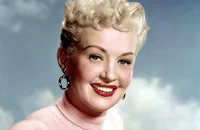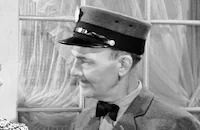The Farmer Takes a Wife
Brief Synopsis
Cast & Crew
Henry Levin
Betty Grable
Dale Robertson
Thelma Ritter
John Carroll
Eddie Foy Jr.
Film Details
Technical Specs

Synopsis
In 1850, the citizens of Rome, New York await the annual opening of the Erie Canal, which is the main method of transporting goods from Europe to the West Coast. Molly Larkins, the pretty cook for Jotham Klore, the tough captain of the Old Hickory , is so disgusted that Jotham has once again gotten drunk and wrecked havoc in her kitchen that she quits. Molly seeks comfort from Lucy Cashdollar, the wealthiest woman in town, but when Lucy accompanies Molly back to the barge, they discover that the repentent Jotham has cleaned up. Molly is appeased by Jotham's promise that he will not drink or fight without a good reason, and by his assurance that they will marry someday. Needing a new driver for the boat's horses, which are used to pull the boats through the canal, Molly goes to Lucy's employment agency, but all of the men, fearing Jotham, decline the job. One man, Dan Harrow, does volunteer, although Molly is aghast to learn that he is a farmer, an occupation upon which the "canalers" look down. With no other option, Molly hires Dan, who is only seeking transport to Buffalo, where he intends to meet up with his girl friend, Susanna. Susanna's parents do not approve of the penniless Dan and are taking her to Illinois, but Dan hopes that the driving job will change their minds and enable him to settle on a farm with her. As Molly shows Dan around the Old Hickory , they learn that Jotham is fighting with representatives of the encroaching railroad, which the canalers fear will ruin their trade. When Molly's eagerness to view the fight lands her in the canal, Dan gallantly dives in to save her, only to discover that the canal is four feet deep. Despite the fact that Dan gets stuck headfirst in the mud, Molly is touched by his chivalry, which is a sharp contrast to Jotham's rough ways. That night, Molly waits impatiently for Jotham to escort her to a party at Lucy's house, and when he does not arrive, she outfits Dan in Jotham's suit and takes him. The drunken Jotham is infuriated when he sees Dan in his suit but passes out before he can inflict any serious harm. The next day, the boats set out with their cargoes, and Molly anticipates another enjoyable season on the canal. As she spends more time with Dan, Molly falls in love with him, and even connives to have him miss his connection with Susanna in Buffalo. Dan philosophically states that he will catch up with Susanna eventually and continues to serve as the Old Hickory 's driver, although he is unaware of Molly's feelings for him, or of his growing affection for her. Back in Rome, Molly is unsettled by Dan's desire to return to farming, but is glad when he receives a letter from Susanna expressing contentment with her new life. Jotham gets into another fight with some railroad men and is arrested for inciting a riot, after which he is sentenced to a ninety-day jail term and a five hundred dollar fine. Hoping to earn the money to free Jotham, Molly offers to run the Old Hickory with Dan, but Jotham jealously refuses them use of the boat. Determined to make their own money, Molly and Dan pool their resources to buy and restore the Sarsey Sal , the old canal boat upon which Molly was born. Soon the Sarsey Sal is in fine shape, and Molly and Dan transport cargo that other canalers disdain, such as pigs and fertilizer. Upon their return to Rome, Molly and Dan buy presents for each other and finally declare their love. Soon after, they learn that Susanna has married an Illinois farmer, and plan to enter the Sarsey Sal in the upcoming annual canal race. Molly is upset, however, when Dan announces that he intends to use their winnings to settle down with her on a farm. Angered that Dan made up his mind without consulting her, Molly leaves him and, with the help of Fortune Friendly, Lucy's peddler beau, raises enough money to pay Jotham's fine. Molly and Jotham then enter the Old Hickory in the race, and Fortune agrees to drive for the despondent Dan. During the race, Jotham overhears Molly telling Dan that she loves him but wants him to lose the race so that he will not have enough money to buy a farm. Enraged, Jotham engages Dan in a fistfight, which ends with Jotham being tossed into the canal. Dan sweeps Molly into his arms and carries her to the Sarsey Sal , then handily wins the race. Soon after, Dan and Molly and Lucy and Fortune celebrate a double wedding, and Molly admits that she is glad to be a farmer's wife.

Director

Henry Levin
Cast

Betty Grable

Dale Robertson

Thelma Ritter

John Carroll
Eddie Foy Jr.
Charlotte Austin
Kathleen Crowley

Merry Anders
Donna Lee Hickey
Noreen Michaels

Ruth Hall
William Pullen
Juanita Evers
Mort Mills
Lee Turnbull
Howard Negley
Joanne Jordan
Gene Roth
Mel Pogue

Gwyneth Verdon
Fred Graham
Jack Stoney

John Butler
Gordon Nelson
Ralph Sanford
Paul Mcguire
Zon Murray
Bob Adler
Harry Carter
Wesley Hudman
Fredric Santley
Ed Rickard
Robert B. Williams
Martin Deane
Bobby Hyatt
Brad Mora
Kip Mckay
Tony Taylor
Erik Nielson
Bobby Taylor
Fred Aldrich
Ed Hinton
Max Wagner
John Close
Paul Kruger
Ralph Montgomery
Emile Meyer
Don Garrett
Bill Foster
Robert Mcphillips
Jack Harris
Kermit Maynard
Ted Jordan
James Hickman
Susan Odin
Judy Ann Whaley

Lee Phelps
Donald Kerr
Ervin Richardson
Crew
Lloyd Allen
Harold Arlen
Arthur E. Arling
Sally Benson
Sid Bowen
Jerry Bryan
Walter Bullock
Claude Carpenter
Jack Cole
Leonard Doss
Dorothy Fields
Joseph Fields
Max Golden
Eugene Grossman
Earle Hagen
Addison Hehr
Roger Heman
Charles Henderson
Ray Kellogg
Albert J. Kramer
Charles Lemaire
Louis Loeffler
Cyril Mockridge
Lionel Newman
Ben Nye
Joseph E. Rickards
Frank P. Rosenberg
Stanley Scheuer
Herbert Spencer
Travilla
Lyle Wheeler
Joseph C. Wright

Film Details
Technical Specs

Quotes
Don't forget, I'm a five time widow, and when they died they all left me everything they owned. Rest their souls.- Lucy Cashdollar
What do you want with me? I'm broke.- Fortune Friendly
Well, I figure after five rich husbands, the next one would be on the house.- Lucy Cashdollar
Trivia
Notes
According to a Hollywood Reporter news item, Twentieth Century-Fox first considered remaking its 1935 production of The Farmer Takes a Wife, which was directed by Victor Fleming and starred Janet Gaynor and Henry Fonda, in 1944 in a version to be produced by Robert Bassler and star Lon McCallister and Jeanne Crain. (See entry in AFI Catalog of Feature Films, 1931-40 for information about the 1935 production.) The project was shelved until August 1951, when it was announced that Mitzi Gaynor would be the star of a musical remake of the story. In November 1951, Los Angeles Times reported that Victor Mature would be starring in the film, but on April 28, 1952, Hollywood Reporter noted that Mature's casting in Something for the Birds (see below) prevented his appearance in The Farmer Takes a Wife. The same Hollywood Reporter news item announced that James Arness was being considered for a role, but he does not appear in the completed picture.
Hollywood Reporter news items include George Magrill, Ruth Peppel, Andrew Jackson IV, Gloria Gordon and Tim Shamroy, the ten-year-old son of cinematographer Leon Shamroy, in the cast, but their appearance in the completed film has not been confirmed. Although a July 10, 1952 Hollywood Reporter news item stated that Casey Adams would "audition" songs for the picture, the extent of his contribution to the completed film, if any, has not been determined.
According to the pressbook, a dance number featuring Betty Grable in a dream sequence, which consisted of "an entire reel in length," was filmed over the course of a week, after taking a month to rehearse. The production number was dropped before the film's release, however. As noted in Hollywood Reporter news items and studio publicity, the opening title cards include drawings by noted primitives painter Albert J. Kramer, which depict the Erie Canal during different seasons. The ending production number, featuring the double wedding ceremony, was styled by art director Addison Hehr to resemble Grant Wood's painting "Farm House."
The Farmer Takes a Wife marked the screen debut of actress Kathleen Crowley and was also the last major starring vehicle for Betty Grable, who ended her longterm contract with Twentieth Century-Fox after her next picture, How to Marry a Millionaire, in which she co-starred with Marilyn Monroe and Lauren Bacall (see below).












